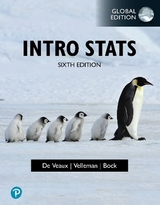
Intro Stats
Pearson Education Limited (Verlag)
978-1-292-02250-5 (ISBN)
- Titel erscheint in neuer Auflage
- Artikel merken
New to the Fourth Edition is a streamlined presentation that keeps students focused on what’s most important, while including out helpful features. An updated organization divides chapters into sections, with specific learning objectives to keep students on track. A detailed table of contents assists with navigation through this new layout. Single-concept exercises complement the existing mid- to hard-level exercises for basic skill development.
Dick De Veaux (Williams College) is an award-winning teacher and consultant to major corporations. His real-world experiences and anecdotes illustrate many of the chapters. Dick has taught business students at Wharton, engineering students at Princeton, and liberal arts students at Williams. Dick was named the 2008 Mosteller Statistician of the Year, awarded by the Boston chapter of the American Statistical Association for exceptional contributions to the field of statistics and outstanding service to the statistical community. To learn more, please go to: http://www.williams.edu/admin/news/releases/1624/. Paul Velleman (Cornell University) is the only statistician to win the EDUCAUSE award for innovating technology for learning. The developer of ActivStats® multimedia software, Data Desk® statistics software, and the DASL online archive of teaching datasets, his understanding of using and teaching with technology informs much of the book’s approach. David Bock (Cornell University) won awards as a high school teacher of AP calculus and statistics and was a grader for the AP Statistics program from its inception. He is now the chief extension officer for the Cornell University mathematics department in charge of outreach to K-12 teachers. Dave’s wisdom about how students learn helps to shape the book’s pedagogy.
Preface
Index of Applications
Part I. Exploring and Understanding Data
1. Stats Starts Here!
1.1 What Is Statistics?
1.2 Data
1.3 Variables
2. Displaying and Describing Categorical Data
2.1 Summarizing and Displaying a Single Categorical Variable
2.2 Exploring the Relationship Between Two Categorical Variables
3. Displaying and Summarizing Quantitative Data
3.1 Displaying Quantitative Variables
3.2 Shape
3.3 Center
3.4 Spread
3.5 Boxplots and 5-Number Summaries
3.6 The Center of Symmetric Distributions: The Mean
3.7 The Spread of Symmetric Distributions: The Standard Deviation
3.8 Summary—What to Tell About a Quantitative Variable
4. Understanding and Comparing Distributions
4.1 Comparing Groups with Histograms
4.2 Comparing Groups with Boxplots
4.3 Outliers
4.4 Timeplots: Order, Please!
4.5 Re-expressing Data: A First Look
5. The Standard Deviation as a Ruler and the Normal Model
5.1 Standardizing with z-Scores
5.2 Shifting and Scaling
5.3 Normal Models
5.4 Finding Normal Percentiles
5.5 Normal Probability Plots
Review of Part I: Exploring and Understanding Data
Part II. Exploring Relationships Between Variables
6. Scatterplots, Association, and Correlation
6.1 Scatterplots
6.2 Correlation
6.3 Warning: Correlation ≠ Causation
6.4 Straightening Scatterplots
7. Linear Regression
7.1 Least Squares: The Line of "Best Fit"
7.2 The Linear Model
7.3 Finding the Least Squares Line
7.4 Regression to the Mean
7.5 Examining the Residuals
7.6 R2—The Variation Accounted for by the Model
7.7 Regression Assumptions and Conditions
8. Regression Wisdom
8.1 Examining Residuals
8.2 Extrapolation: Reaching Beyond the Data
8.3 Outliers, Leverage, and Influence
8.4 Lurking Variables and Causation
8.5 Working with Summary Values
Review of Part II: Exploring Relationships Between Variables
Part III. Gathering Data
9. Understanding Randomness
9.1 What is Randomness?
9.2 Simulating By Hand
10. Sample Surveys
10.1 The Three Big Ideas of Sampling
10.2 Populations and Parameters
10.3 Simple Random Samples
10.4 Other Sampling Designs
10.5 From the Population to the Sample: You Can't Always Get What You Want
10.6 The Valid Survey
10.7 Common Sampling Mistakes, or How to Sample Badly
11. Experiments and Observational Studies
11.1 Observational Studies
11.2 Randomized, Comparative Experiments
11.3 The Four Principles of Experimental Design
11.4 Control Treatments
11.5 Blocking
11.6 Confounding
Review of Part III: Gathering Data
Part IV. Randomness and Probability
12. From Randomness to Probability
12.1 Random Phenomena
12.2 Modeling Probability
12.3 Formal Probability
13. Probability Rules!
13.1 The General Addition Rule
13.2 Conditional Probability and the General Multiplication Rule
13.3 Independence
13.4 Picturing Probability: Tables, Venn Diagrams and Trees
13.5 Reversing the Conditioning and Bayes' Rule
14. Random Variables and Probability Models
14.1 Expected Value: Center
14.2 Standard Deviation
14.3 Combining Random Variables
14.4 The Binomial Model
14.5 Modelin
| Erscheint lt. Verlag | 5.8.2013 |
|---|---|
| Verlagsort | Harlow |
| Sprache | englisch |
| Maße | 216 x 275 mm |
| Gewicht | 1848 g |
| Themenwelt | Mathematik / Informatik ► Mathematik |
| ISBN-10 | 1-292-02250-7 / 1292022507 |
| ISBN-13 | 978-1-292-02250-5 / 9781292022505 |
| Zustand | Neuware |
| Haben Sie eine Frage zum Produkt? |
aus dem Bereich



